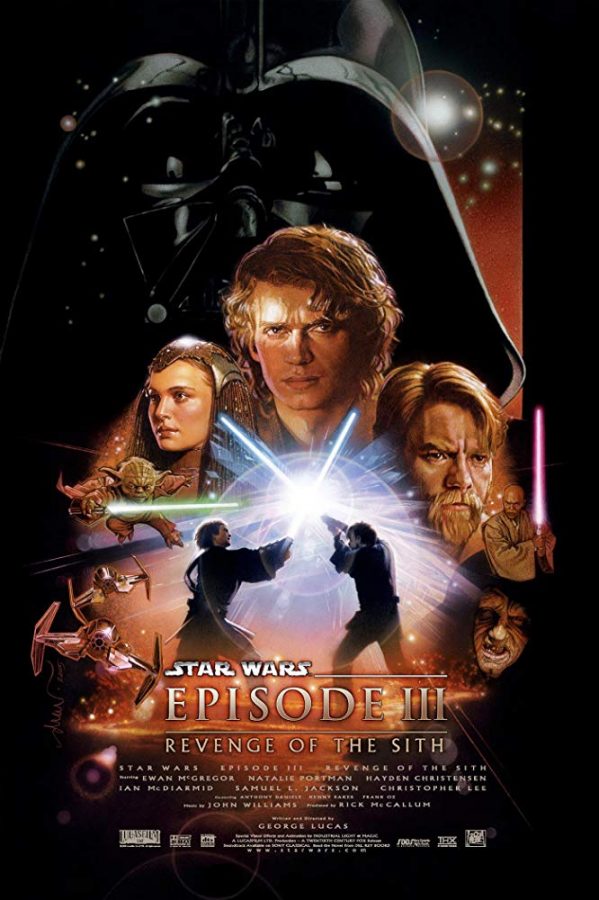Star Wars: Episode III – Revenge of the Sith
The “Good” Prequel
November 18, 2019
2005 would prove to be the year of the supposed end of the Star Wars saga with the release of the first PG-13 rated Star Wars film, Star Wars: Episode III – Revenge of the Sith. In this comparatively dark conclusion to the prequel trilogy, audiences would finally get to witness the promised fall of Anakin Skywalker and the rise of Darth Vader. Lucas’ talents are on complete display, only partially hindered by his trademark faults, giving a compelling ending to the prequel trilogy.
Returning from Star Wars: Episode II – Attack of the Clones is Hayden Christensen, Ewan Mcgregor, Ian McDiarmid, Natalie Portman, and Samuel L. Jackson as their respective characters. With an emphasis on an interesting social triangle between Anakin Skywalker, Padmé Amidala and Obi-Wan Kenobi, all three were tasked with putting on their best performances for this seemingly final chapter in the Star Wars saga. In this final entry in the prequel trilogy, the CGI holds up much better this time around, but still remains only a minor improvement over the previous two installments.
Opening in the midst of the clone wars, Anakin Skywalker (Hayden Christensen) is now a Jedi knight, and Obi-Wan (Ewan McGregor) has been given the rank of master. Together they aim to intercept the kidnapping of Chancellor Palpatine (Ian McDiarmid) from the clutches of the Jedi hunter, General Grievous (Matthew Wood) and Count Dooku (Christopher Lee), all occurring in the congested aerial battlefield above Coruscant. After the epic opening, the film delves into the transformation of Anakin into Darth Vader, leading to some of the saga’s darkest moments, moments that elevate the movie emotionally beyond the prior two installments. The audience witnesses Anakin’s torment, which is most elevated by Williams’ score and stunning visuals.
The acting in this film, like most other elements in this film, is far superior to its predecessors. Christensen, though a bit lackluster on verbal delivery, nails the visual pain that the torn chosen one must display. Between a mixture of anger and sadness, the dichotomy between Anakin and his former master, Obi-Wan Kenobi, is expertly handled in the latter half of the film, with Ewan McGregor making his name synonymous with the character though his genuine portrayal of the soon-to-be Jedi hermit. Furthermore, Ian McDiarmid fully delivers on the anticipated emergence of Darth Sidious and his infamous plot, “Order 66”, to enact his galactic empire.
Beyond a welcomed improvement in performance, Lucas’ creative energy is used to its maximum in this film, introducing a plethora of world-building that creates a dynamic and grand scale for the epic conclusion of the prequel trilogy. Planets like Utapau, Felucia, Mustafar, and Kashyyyk feel real and lived in through the updated visual effects at ILM studio. Beyond this, the easy standout in this film is John Williams’ score, which makes masterclass use of a grand orchestra and an ethereal choir. Williams’ classic leitmotifs frequently appear in this entry, making for powerful tracks, with some of the best including “Battle of the Heroes” and “Anakin’s Betrayal”. This is easily the best representation of the prequel trilogy, including both beautiful concepts from George Lucas, but also his trademark screenwriting weaknesses. Star Wars: Episode III – Revenge of the Sith manages to maintain its identity as a solid entry into the Star Wars saga, even with its “Lucasian” faults earning its rating of a 7/10. Do you agree with my review? Comment below and let me know what you think of Star Wars: Episode III – Revenge of the Sith. Be sure to follow my Star Wars film review series as we near the end of the Skywalker saga with Star Wars: Episode IX – The Rise of Skywalker!



